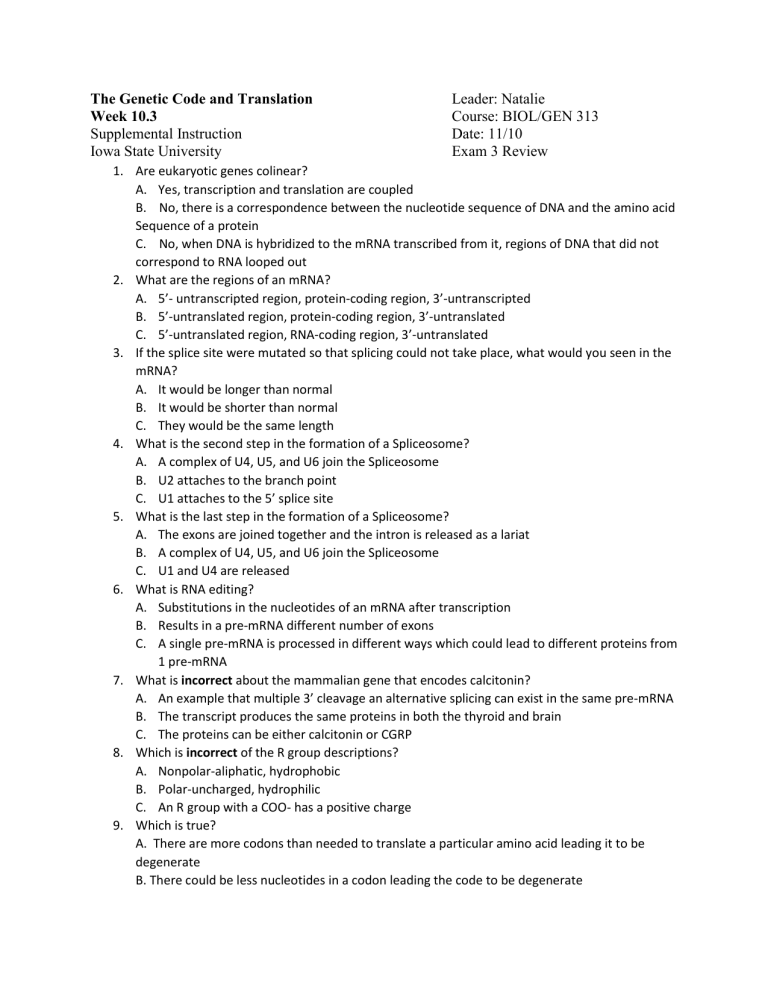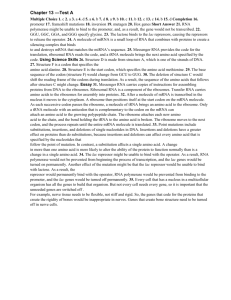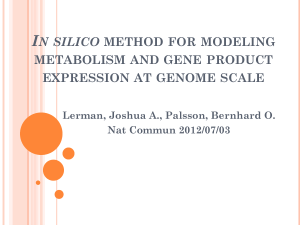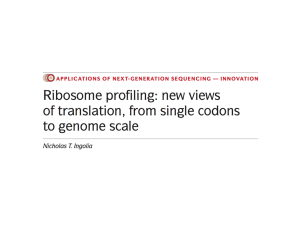Exam 3 Review - Iowa State University

The Genetic Code and Translation
Week 10.3
Supplemental Instruction
Iowa State University
Leader: Natalie
Course: BIOL/GEN 313
Date: 11/10
Exam 3 Review
1.
Are eukaryotic genes colinear?
A.
Yes, transcription and translation are coupled
B. No, there is a correspondence between the nucleotide sequence of DNA and the amino acid
Sequence of a protein
C. No, when DNA is hybridized to the mRNA transcribed from it, regions of DNA that did not correspond to RNA looped out
2.
What are the regions of an mRNA?
A.
5’- untranscripted region, protein-coding region, 3’-untranscripted
B.
5’-untranslated region, protein-coding region, 3’-untranslated
C.
5’-untranslated region, RNA-coding region, 3’-untranslated
3.
If the splice site were mutated so that splicing could not take place, what would you seen in the mRNA?
A.
It would be longer than normal
B.
It would be shorter than normal
C.
They would be the same length
4.
What is the second step in the formation of a Spliceosome?
A.
A complex of U4, U5, and U6 join the Spliceosome
B.
U2 attaches to the branch point
C.
U1 attaches to the 5’ splice site
5.
What is the last step in the formation of a Spliceosome?
A.
The exons are joined together and the intron is released as a lariat
B.
A complex of U4, U5, and U6 join the Spliceosome
C.
U1 and U4 are released
6.
What is RNA editing?
A.
Substitutions in the nucleotides of an mRNA after transcription
B.
Results in a pre-mRNA different number of exons
C.
A single pre-mRNA is processed in different ways which could lead to different proteins from
1 pre-mRNA
7.
What is incorrect about the mammalian gene that encodes calcitonin?
A.
An example that multiple 3’ cleavage an alternative splicing can exist in the same pre-mRNA
B.
The transcript produces the same proteins in both the thyroid and brain
C.
The proteins can be either calcitonin or CGRP
8.
Which is incorrect of the R group descriptions?
A.
Nonpolar-aliphatic, hydrophobic
B.
Polar-uncharged, hydrophilic
C.
An R group with a COO- has a positive charge
9.
Which is true?
A. There are more codons than needed to translate a particular amino acid leading it to be degenerate
B. There could be less nucleotides in a codon leading the code to be degenerate
C. The code is degenerate because there is not enough codons to encode for all the amino acids
10.
Which of these is Not a sense codon?
A.
AUG
B.
UAA
C.
CCC
11.
What are isoaccepting tRNAs?
A.
They recognize both the amino acid and all the tRNAs that accept that amino acid
B.
Codons that specify the same amino acid
C.
Different tRNAs that accept the same amino acid but have different anticodons
12.
Which is true of Beadle and Tatum’s studies?
A.
They irradiated spores of Neurospora to induce mutations
B.
Spores with auxotrophic mutations could grow on minimal medium
C.
Hypothesized that one gene encoded many enzymes
13.
Which is False about the wobble hypothesis?
A.
Through wobble a single anticodon can pair with more than one codon
B.
Pairing at the 3rd position of the codon and at the 1st position of the anticodon is relaxed
C.
Solves the problem of having too few aminoacyl- tRNA synthetases to recognize all the amino acids
14.
Which is incorrect about EMG1?
A.
A single mutation in EMG1 can cause Bowen-Conradi syndrome
B.
A mutation in the EMG1 gene was passed on due to the founder effect
C.
A mutation in EMG1 results in having different sized ribosomes
15.
Which of these levels of protein structure is incorrect?
A.
Primary structure is the linear sequence of amino acids
B.
Secondary structure are the beta helices and alpha sheets
C.
Quaternary structure is the polypeptide chains
16.
Which of these statements are correct about ribosomes?
A.
The eukaryotic ribosome subunits are the 30S and the 50S
B.
The prokaryotic ribosome subunits are 40S and 60S
C.
Prokaryotes make the 70S complex while eukaryotes form the 80S complex
17.
What is the second stage of translation?
A.
Initiation
B.
tRNA charging
C.
elongation
18.
What sequence of 3 nucleotides is always present at the 3’ end of the acceptor stem of tRNAs?
A.
5’-CCA-3’
B.
5’-ACC-3’
C.
5’-CCG-3’
19.
What sequence is required for RNA binding in prokaryotic initiation?
A.
Kozak sequence
B.
The Shine-Dalgarno sequence
C.
TATA box
20.
Which of these is correct?
A.
The 70S complex is made up of the small subunit of ribosome, mRNA, f-Met-tRNA, GTP, IF factors
B.
The Shine-Dalgarno sequence binds to 23rRNA
C.
mRNA binds to the small subunit of the ribosome
21.
Why is translation a good target for antibiotics?
A.
They target both prokaryotic and eukaryotic ribosomes
B.
Translation differs significantly between bacterial and eukaryotic cells
C.
Tetracyclines and neomycin target the E site of the ribosomes to prevent charged tRNA binding
22.
How are the 3 sites on the ribosome arranged?
A.
P-peptidyl, A-aminoacyl, E-exit
B.
E- exit, P-peptidyl, A-aminoacyl
C.
A-aminoacyl, P-peptidyl, E-exit
23.
Which of these differences between bacterial and eukaryotic translation is False?
A.
Bacterial translation has more initiation factors
B.
The large subunit of a eukaryotic ribosome contains 3 rRNAs, prokaryotes only have 2
C.
In prokaryotes the small subunit of the ribosome attaches to the Shine-Dalgarno sequence and a sequence at the 3’ end on the 16S rRNA
24.
Which of these levels of gene regulation occur in eukaryotes but not prokaryotes?
A.
Translation
B.
mRNA processing
C.
post-translational modification
25.
What makes up an operon?
A.
A single transcriptional unit with an operator, promoter, and regulatory genes
B.
A single transcriptional unit with an operator, promoter, and structural genes
C.
A single transcriptional unit with an operator, promoter, structural, and regulatory genes
26.
The lac operon is an example of what type of operon?
A.
Positive inducible
B.
Negative repressible
C.
Negative inducible
27.
What is the difference between a structural gene and a regulator gene?
A.
Structural genes are transcribed into mRNA, regulatory genes are not
B.
structural genes encode proteins, regulatory genes control the transcription of structural genes
C.
Structural genes have complex structures, regulatory genes have more simple structures
28.
Which is False about Inducible operon?
A.
There can be positive and negative control
B.
Negative inducible have an active repressor
C.
A positive inducible operon has a repressor as its regulatory protein
29.
Motifs
A.
Bind on or near the minor groove
B.
Act to increase transcription
C.
Are rare in eukaryotes
30.
Which is not an example of a DNA-binding motif
A.
Helix-turn-helix
B.
Zinc-finger
C.
Amino-zipper









